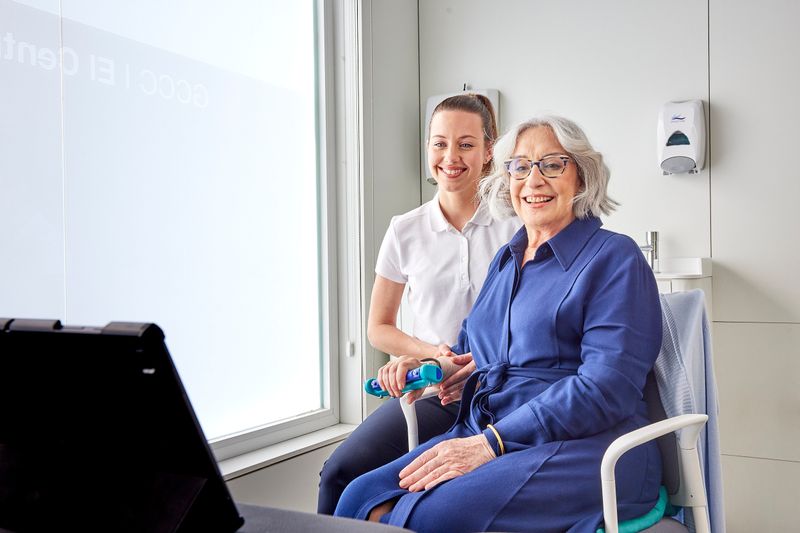Grip strength is a simpler, more objective measure than the 6-minute walk test, directly correlating with functional capacity and offering valuable insights into respiratory disease risk and progression.
It reflects muscle strength, which declines in chronic conditions such as COPD, where systemic inflammation and muscle loss worsen physical performance and increase mortality risk. [Celis-Morales et al., 2018]
This articleexplains how grip strength can be used in clinical practice to assess risk, progression and prognosis in patients with respiratory disease. Read on to find out, how is grip strength related to respiratory disease and mortality risk reduction?
“Grip strength is a key indicator of health; it’s a proxy for your overall strength and physical function.”
‘Outlive’ by Peter Attia MD; Longevity Expert
Must-Know Metrics: Grip Strength and Respiratory Disease
Grip Strength and Risk of Disease Incidence
For patients aged between 40-69: each 7.7 lbs* drop in grip strength increases respiratory-disease related incidence of:
- Respiratory system disease by 22% in women and 17% in men.
- COPD by 20% in women and 15% in men [Celis-Morales et al., 2018]
Grip Strength in the Prediction and Prevention of Respiratory-Disease Related Mortality
If aged between 40-69: each 7.7 lbs* drop in grip strength increases respiratory-disease related mortality of:
- Respiratory system disease by 31% in women and 24% in men.
- COPD by 2% in women and 19% in men [Celis-Morales et al., 2018]
Achieving a grip strength of 62.4 lbs* reduces the risk of respiratory disease mortality by an impressive 51%. [Mey et al., 2022]
Grip Strength for Preserving Independence through Early Detection
There is a link between measuring grip strength and all-cause mortality risk reduction. Grip strength testing identifies functional decline caused by advancing muscle atrophy.
Early interventions, including resistance training or muscle-strengthening activities for 30-60 minutes weekly to improve physical fitness, reduces the risk of all-cause mortality, cardiovascular disease, and cancer by 10-17% [Momma et al., 2022].
*Note that all cut off points have been converted to GripAble-equivalent measurements for consistency
Grip Strength and Respiratory Disease in Practice
Clinical Application
Measure grip strength during routine check-ups to assess risk factors and track trends over time. For high-risk patients, consider providing a hand dynamometer for regular, at-home monitoring. Pay attention when grip strength drops below cut-off points or decreases by more than a quartile.
Patient Empowerment
Give patients access to their grip strength scores. This is a clear, tangible measure they can easily understand and actively improve with guidance. Unlike blood pressure, grip strength is relatable and empowering, enabling patients to track their progress as a key indicator of their independence.
Practical Considerations
Grip strength is a non-invasive, objective measure offering clear insights into patient well-being and can serve as a valuable substitute for patients unable to perform respiratory assessments.
Impact: Grip Strength and Respiratory Disease
Reduce Utilization: better risk stratification and monitoring
Improve Patient Satisfaction: give patients a quick, non-invasive tool to monitor their disease status and response to treatment at home
Support Risk Adjustment: quantify disease impact by using grip strength as an objective measure of muscle loss.
What next?
For further reading, dive into our extensive collection of studies on using a hand dynamometer, grip strength and more here including:
- Grip Strength and Longevity: The New Essential Biomarker
- Grip Strength and Surgery: The New Essential Biomarker
- Grip Strength and Oncology: The New Essential Biomarker
- Grip Strength and Renal Disease: The New Essential Biomarker
- Grip Strength and Gastrointestinal Disease: The New Essential Biomarker
- Grip Strength and Frailty: The New Essential Biomarker
- Grip Strength and Heart Disease: The New Essential Biomarker
- Grip Strength as a Biomarker for Sports Performance
- Grip Strength in Sports Medicine: Use Cases and Recommendations
- What are Biomarkers? The Role of Grip Strength in Modern Healthcare
- Hand Dynamometer Guide: The Essentials
- Able Assess User Guide
Contribute: Partner with us in research or patient case studies to advance the knowledge of grip strength as a biomarker.
Understand: Get the essentials on hand dynamometry and how to integrate grip strength into your practice with our comprehensive guide.
Get in touch: Website: able-care.co Email: hello@able-care.co
Citations
Burtin, C., et al. Handgrip weakness and mortality risk in COPD: A multicentre analysis. Thorax, 71(1), 86-87. (2016) [LINK]
Celis-Morales, CA, et al. Associations of grip strength with cardiovascular, respiratory, and cancer outcomes and all cause mortality: Prospective cohort study of half a million UK Biobank participants. BMJ (Online), 361 (2018). [LINK]
Chen, L., et al. Better pulmonary function is associated with greater handgrip strength in a healthy Chinese Han population. BMC Pulmonary Medicine, 20(1). (2020) [LINK]
Jeong M, et al. Hand grip strength in patients with chronic obstructive pulmonary disease. Int J Chron Obstruct Pulmon Dis. 2017 Aug 9;12:2385-2390. [LINK]
Mey R, et al. Handgrip strength and respiratory disease mortality: Longitudinal analyses from SHARE. Pulmonology. 2024 Sep-Oct;30(5):445-451. [LINK]
Silva, ALG, et al. Handgrip and functional capacity in Chronic Obstructive Pulmonary Disease patients. Fisioterapia Em Movimento, 30(3), 501-507. (2017) [LINK]

